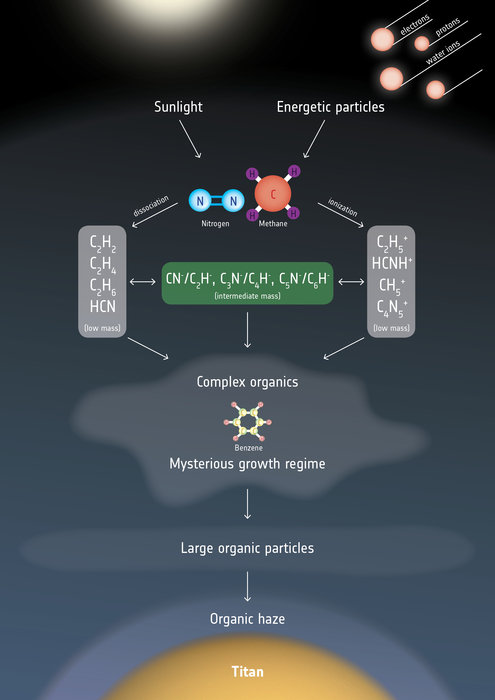
On July 28, 2017, scientists made two separate announcements of new discoveries of organic molecules in the thick atmosphere of Saturn’s large moon Titan. They’re both interesting, because both relate to the idea that Titan’s atmosphere might resemble Earth’s early atmosphere, and/ or because Titan might even now host exotic lifeforms. Chemical and biological engineer Paulette Clancy of Cornell University, who has worked on theoretical studies related to Titan’s atmosphere, told EarthSky by email that the two molecules that had been discovered:
… aren’t related in a chemical sense, beyond the fact that both are organic. And I suspect they serve different purposes on Titan. However, it’s always important to know what ‘ingredients’ are in the ‘kitchen’ when you are cooking a meal.
In this case, the kitchen would be Titan, and its intricate atmosphere and surface features, and the meal would be life itself.
First, some background. Titan’s atmosphere is unlike that of any other moon in our solar system. It’s made mostly of nitrogen, plus hydrocarbons like methane and ethane, and it’s also known to contain an array of complex organic molecules, that is, molecules containing carbon (since earthly life is carbon-based, our definition of “organic” skews that way).
To scientists, organic molecules in Titan’s atmosphere are welcome clues to the mystery of life on other worlds. And that’s why this week’s newly announced discoveries are important.
One was of molecules of vinyl cyanide (acrylonitrile) in Titan’s atmosphere. Astronomers uncovered evidence for it in archival data from the Atacama Large Millimeter Array (ALMA) in Chile. Under the right conditions, possibly like those found at Titan, vinyl cyanide might naturally coalesce into microscopic spheres resembling cell membranes. If you’ll recall your high school science class, you’ll remember that all living things are made of cells. Could there be some form of cellular life on Titan’s surface, perhaps within the large bodies of liquid methane and ethane that scientists call Titan’s lakes?
Read more about the discovery of Titan’s vinyl cyanide via NRAO
The other discovery was of a particular type of negatively charged molecule at Titan. Scientists didn’t expect to find these carbon chain anions, because they’re highly reactive and quickly change form. But they did find them, in data from the Cassini spacecraft, which is now in its final year in orbit around Saturn. The scientists noted they are building blocks towards more complex molecules, and might have acted as the basis for the earliest forms of life on Earth.
Read more about the discovery of Titan’s carbon chain anions via ESA.
Conditions on Titan are not conducive to the formation of life as we know it. At 10 times Earth’s distance from the sun, it’s just too cold there for our kind of life. Titan’s cold gives Titan its weird hydrologic cycle, which is a distant cousin to Earth’s water cycle. On Titan, liquid methane rains from the skies, forming rivers, lakes, and seas. So you can see that, relative to our Earth, Titan is exotic, and, if it does have life, those lifeforms might be exotic as well.
Paulette Clancy, who we mentioned above, works with astronomer Jonathan Lunine of Cornell. These two scientists issued joint statement on Friday, July 28, related to the vinyl cyanide discovery. Lunine said:
This is a step forward in understanding whether Titan’s methane seas might host an exotic form of life.
Saturn’s moon, Enceladus is the place to search for life like us, life that depends on – and exists in – liquid water. Titan, on the other hand, is the place to go to seek the outer limits of life. Can some exotic type of life begin and evolve in a truly alien environment, that of liquid methane?
Exciting question!

Bottom line: A short synopsis of two announcements of new discoveries of organic molecules in the thick atmosphere of Saturn’s moon Titan.











